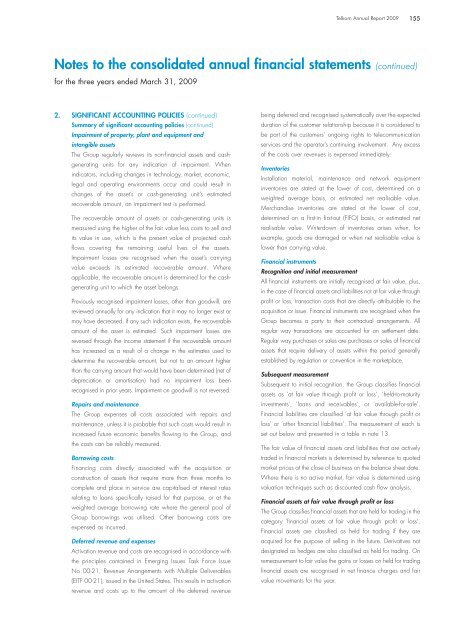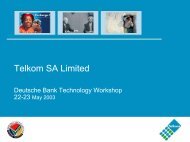Telkom AR front.qxp
Telkom AR front.qxp
Telkom AR front.qxp
You also want an ePaper? Increase the reach of your titles
YUMPU automatically turns print PDFs into web optimized ePapers that Google loves.
2. SIGNIFICANT ACCOUNTING POLICIES (continued)<br />
Summary of significant accounting policies (continued)<br />
Impairment of property, plant and equipment and<br />
intangible assets<br />
The Group regularly reviews its non-financial assets and cashgenerating<br />
units for any indication of impairment. When<br />
indicators, including changes in technology, market, economic,<br />
legal and operating environments occur and could result in<br />
changes of the asset’s or cash-generating unit’s estimated<br />
recoverable amount, an impairment test is performed.<br />
The recoverable amount of assets or cash-generating units is<br />
measured using the higher of the fair value less costs to sell and<br />
its value in use, which is the present value of projected cash<br />
flows covering the remaining useful lives of the assets.<br />
Impairment losses are recognised when the asset’s carrying<br />
value exceeds its estimated recoverable amount. Where<br />
applicable, the recoverable amount is determined for the cashgenerating<br />
unit to which the asset belongs.<br />
Previously recognised impairment losses, other than goodwill, are<br />
reviewed annually for any indication that it may no longer exist or<br />
may have decreased. If any such indication exists, the recoverable<br />
amount of the asset is estimated. Such impairment losses are<br />
reversed through the income statement if the recoverable amount<br />
has increased as a result of a change in the estimates used to<br />
determine the recoverable amount, but not to an amount higher<br />
than the carrying amount that would have been determined (net of<br />
depreciation or amortisation) had no impairment loss been<br />
recognised in prior years. Impairment on goodwill is not reversed.<br />
Repairs and maintenance<br />
The Group expenses all costs associated with repairs and<br />
maintenance, unless it is probable that such costs would result in<br />
increased future economic benefits flowing to the Group, and<br />
the costs can be reliably measured.<br />
Borrowing costs<br />
Financing costs directly associated with the acquisition or<br />
construction of assets that require more than three months to<br />
complete and place in service are capitalised at interest rates<br />
relating to loans specifically raised for that purpose, or at the<br />
weighted average borrowing rate where the general pool of<br />
Group borrowings was utilised. Other borrowing costs are<br />
expensed as incurred.<br />
Deferred revenue and expenses<br />
Activation revenue and costs are recognised in accordance with<br />
the principles contained in Emerging Issues Task Force Issue<br />
No 00-21, Revenue Arrangements with Multiple Deliverables<br />
(EITF 00-21), issued in the United States. This results in activation<br />
revenue and costs up to the amount of the deferred revenue<br />
<strong>Telkom</strong> Annual Report 2009 155<br />
Notes to the consolidated annual financial statements (continued)<br />
for the three years ended March 31, 2009<br />
being deferred and recognised systematically over the expected<br />
duration of the customer relationship because it is considered to<br />
be part of the customers’ ongoing rights to telecommunication<br />
services and the operator’s continuing involvement. Any excess<br />
of the costs over revenues is expensed immediately.<br />
Inventories<br />
Installation material, maintenance and network equipment<br />
inventories are stated at the lower of cost, determined on a<br />
weighted average basis, or estimated net realisable value.<br />
Merchandise inventories are stated at the lower of cost,<br />
determined on a first-in first-out (FIFO) basis, or estimated net<br />
realisable value. Write-down of inventories arises when, for<br />
example, goods are damaged or when net realisable value is<br />
lower than carrying value.<br />
Financial instruments<br />
Recognition and initial measurement<br />
All financial instruments are initially recognised at fair value, plus,<br />
in the case of financial assets and liabilities not at fair value through<br />
profit or loss, transaction costs that are directly attributable to the<br />
acquisition or issue. Financial instruments are recognised when the<br />
Group becomes a party to their contractual arrangements. All<br />
regular way transactions are accounted for on settlement date.<br />
Regular way purchases or sales are purchases or sales of financial<br />
assets that require delivery of assets within the period generally<br />
established by regulation or convention in the marketplace.<br />
Subsequent measurement<br />
Subsequent to initial recognition, the Group classifies financial<br />
assets as ’at fair value through profit or loss’, ’held-to-maturity<br />
investments’, ’loans and receivables’, or ’available-for-sale’.<br />
Financial liabilities are classified ’at fair value through profit or<br />
loss’ or ’other financial liabilities’. The measurement of each is<br />
set out below and presented in a table in note 13.<br />
The fair value of financial assets and liabilities that are actively<br />
traded in financial markets is determined by reference to quoted<br />
market prices at the close of business on the balance sheet date.<br />
Where there is no active market, fair value is determined using<br />
valuation techniques such as discounted cash flow analysis.<br />
Financial assets at fair value through profit or loss<br />
The Group classifies financial assets that are held for trading in the<br />
category ’financial assets at fair value through profit or loss’.<br />
Financial assets are classified as held for trading if they are<br />
acquired for the purpose of selling in the future. Derivatives not<br />
designated as hedges are also classified as held for trading. On<br />
remeasurement to fair value the gains or losses on held for trading<br />
financial assets are recognised in net finance charges and fair<br />
value movements for the year.




